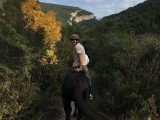If you want to enjoy a sunny Sunday surrounded by nature, we recommend visiting an adventure forest. Why? Without doubt it's a complete experience where you'll see the forest from its highest points while zipping from one area to another.
Ah, ziplines can also be found in mountains, as part of a via ferrata or canyon route, essential for crossing certain points that would otherwise be impossible.

But do you know the necessary techniques? You'll need to know them if you're going to face a situation where you need to cross one or if you ever have to build your own zipline... Here are some tips:
To install the zipline you'll need to start by attaching a pulley to an anchor line, preferably a short one. We'll have two other lines that will serve as self-belays, accompanied by an additional cable (highly recommended, though not all ziplines have this).
We'll need a progression rope with its own safety system; it serves two purposes:
- Allows us to slide
- Provides safety

The rope must be static, minimum 12mm and capable of supporting 4,000 Kg. It's important to tension the rope, for which devices like the Grigri or, alternatively, a descender-blocker (Stop) should be used.
Important: pay special attention when re-tensioning the zipline multiple times, as this can cause rope wear, rendering it unusable.
Types of ziplines
- Descending zipline. In this case you descend vertically with hands and feet ready to brake against the wall if needed. The last person will brake the others using a rope connecting their harness to the descending person's harness. The rope passes through a carabiner attached to one of the zipline's starting anchors.

- Ascending zipline. To traverse this, keep your body horizontal with your head forward and feet backward. Keep your legs as horizontal as possible and, if you can, position your ankles above the cable.
Ready for action?











